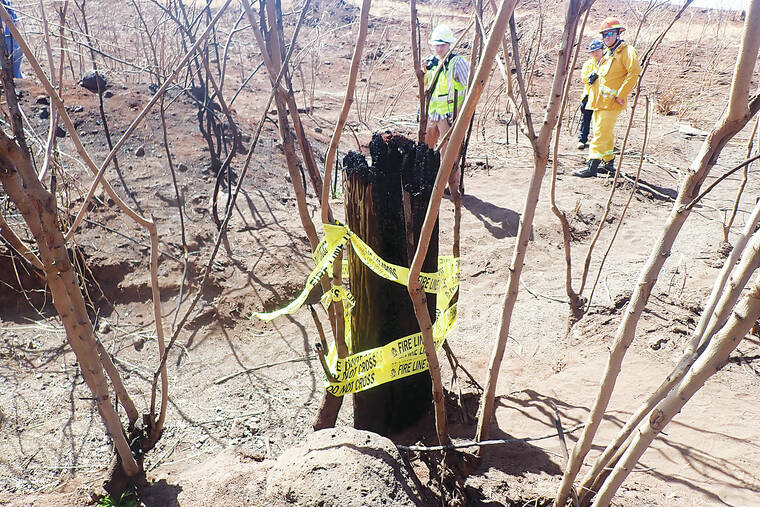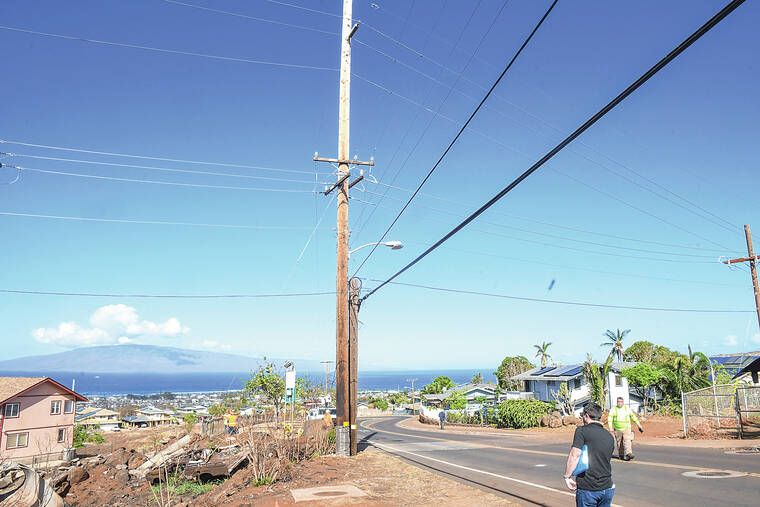An old car tire, burnt trees and a utility pole may be key in finding how the Maui wildfire spread
Melted remains of an old car tire. Heavily burned trees. A charred stump of an abandoned utility pole.
Investigators are examining these and other pieces of evidence as they seek to solve the mystery of last month’s deadly Maui wildfire: How did a small, wind-whipped fire sparked by downed power lines and declared extinguished flare up again hours later into a devastating inferno?
ADVERTISING
The answer may lie in an overgrown gully beneath Hawaiian Electric Co. power lines and something that harbored smoldering embers from the initial fire before rekindling in high winds into a wall of flame that quickly overtook the town of Lahaina, destroying thousands of structures and killing at least 97 people.
But as investigators sift through blackened debris to explain the deadliest U.S. wildfire in more than a century, one fact has become clear: Hawaiian Electric’s right-of-way was untrimmed and unkempt for years, despite being in an area classified as being at high risk for wildfires.
Aerial and satellite imagery reviewed by The Associated Press show the gully has long been choked with thick grass, shrubs, small trees and trash, which a severe summer drought turned into tinder-dry fuel for fires. Photos taken after the blaze show charred foliage in the utility’s right-of-way still more than 10 feet high.
“It was not manicured at all,” said Lahaina resident Gemsley Balagso, who has lived next to the gully for 20 years and never saw it mowed. He watched and took video Aug. 8 after the flames reignited there and were stoked by winds from a hurricane churning offshore.
“The winds were blowing 90 miles an hour (145 kmh) downhill,” Balagso told the AP. “From the time of reignition or rekindling to the time it passed my house, it was less than a minute.”
Though findings of a cause are not expected for months, the focus on Hawaiian Electric’s role in managing brush in its right-of-way could strengthen claims of negligence against the utility, which is facing an onslaught of lawsuits blaming it for failing to proactively cut electricity in the face of high-wind warnings, upgrade its power poles and clear foliage from around its lines.
Hawaiian Electric has acknowledged its downed lines caused the initial fire but has argued in court filings it couldn’t be responsible for the later flare-up because its lines had been turned off for hours by the time the fire reignited and spread through the town. The utility instead sought to shift the blame to Maui County fire officials for what it believes was their premature, false claim that they had extinguished the first fire. The county denies firefighters were negligent.
Since taking that position in late August, Hawaiian Electric’s besieged stock has rebounded by over a third as investors bet the company will survive a legal fight over liability for the disaster estimated to have caused $5.5 billion in damage.
Asked about the overgrown gully, Hawaiian Electric said in a statement to AP that the right-of-way allows it to “remove anything that interferes with our lines and could potentially cause an outage” but does not allow it to ”go on to private property to perform landscaping or grass-mowing.”
The landowner, Kamehameha Schools, run by a $15 billion educational endowment and also named in litigation over the Maui fire, told AP it has “no control over and cannot interfere with” Hawaiian Electric’s equipment in the right-of-way but “never had any objection” to the utility doing work to keep the area safe from its poles and lines.
It’s a point of contention. National standards don’t specifically call for utilities to clear away vegetation unless it is tall enough to reach their lines, but fire science experts say utilities should go beyond that in wildfire areas to remove excess brush that could fuel a fire.
•••
CLUES IN THE INVESTIGATION
Investigators led by the federal Bureau of Alcohol, Tobacco, Firearms and Explosives and Maui County have declined to comment on specifics of the ongoing probe.
But AP reviewed more than 950 photos taken last month showing ATF and Maui investigators combing through the gully area, marking items with yellow tape, and examining splintered power poles, severed electrical lines and other evidence. The photos were given to the AP by Morgan &Morgan, a law firm suing Hawaiian Electric on behalf of residents who lost their homes.
Three fire science experts who examined the photos for the AP noticed several items that could be possible ignition sources for the rekindled fire. They include a heavily charred, hollowed 4-foot-tall stump of a utility pole that was marked with yellow tape, pulled from the ground with a crane and trucked to an evidence warehouse. Investigators also examined two heavily burned trees and piles of rocks strewn with trash, including the remains of an old car tire, its frayed steel belts poking through melted rubber.
While experts cautioned the right-of-way was full of places where embers could fester, they noted that these larger items stood out because the second fire erupted hours later, and stumps and roots have been known to keep embers glowing a long time, in some cases weeks.
“Obviously a quarter-inch diameter twig is probably not going to smolder for five hours because there’s not going to be enough fuel,” said Vyto Babrauskas, a New York-based expert on smoldering fires. “But a big thing like a tree stump or a power pole stump, certainly there’s no reason it would be unable to smolder.”
Hawaiian Electric said the old pole stump was left behind when a new pole was installed next to it. It did not respond to questions about whether it is company policy to leave old poles in place after they are replaced.
The utility said the charred stump was removed at the request of ATF investigators, but that lots of material in the area was collected out of an “abundance of caution.”
•••
TIMELINE OF TWO FIRES
The investigation also appears to be focusing on what happened between the first and second flare-ups, particularly a crucial 36-minute gap between the time fire crews left the scene and the first 911 calls reporting that the fire had rekindled.
As the AP first reported last month, videos taken by two Lahaina homeowners on Aug. 8 show that utility poles and lines along Lahainaluna Road were snapped by strong winds shortly after 6:30 a.m., igniting tall grass and brush below. Maui County firefighters arrived within minutes and began dousing the flames.
By 10 a.m., firefighters deemed the 3-acre blaze “100 percent contained.” Maui County lawyer John Fiske said firefighters continued to spray the area with 23,000 gallons of water, and after seeing no more smoke or flame, declared the fire “extinguished and left at 2:18 p.m.
Balagso, who lives about 130 yards (119 meters) from where the utility’s power lines snapped in the morning, said that at 2:50 p.m. he saw smoke again, billowing from the overgrown gully next to his yard. He called 911 at 2:54 and began recording video that shows orange flames as high as a house leaping from the gully.
Firefighters returned to the area within minutes. But by then it was too late.
Fiske said fire crews attacked the fire with water at both ends of the gully, but winds were so strong that embers flew over their heads, lighting a field of tall grass behind them.
“When the fast winds come in … it just picks the fire up and puts it right over the firefighters,” said Fiske, who represents the county in a lawsuit against Hawaiian Electric. “There’s nothing the firefighters can do.”
Within about 20 minutes, the fire had moved through the field and jumped the four-lane Lahaina Bypass, igniting homes on the other side. From there, it burned through Lahaina’s historic downtown all the way to the ocean, moving so quickly that many residents were forced to jump into the sea to escape.
Balagso, who was interviewed by ATF investigators, says he isn’t sure what caused the fire to rekindle in the gully. But he doesn’t think it was the abandoned utility pole stump, which he remembers seeing in Hawaiian Electric’s right-of-way for the 20 years he’s lived there. He said the flames began farther uphill and were already growing by the time they reached the stump, which kept burning until around 5 p.m., when he extinguished it with a garden hose.
•••
‘VEGETATION MANAGEMENT’
Hawaiian Electric has faced scrutiny before for potentially sparking a wildfire in that same area.
In 2018, a brush fire broke out nearby during high winds from a passing hurricane, destroying 21 buildings. Though officials were unable to conclusively determine a cause, a copy of the investigative report obtained by the AP said Hawaiian Electric’s power lines couldn’t be ruled out.
It’s not clear when Hawaiian Electric last cleared the grass and shrubs from under its lines on the Kamehameha tract. But AP’s review of public regulatory filings shows the company has a history of falling behind on what the electricity industry calls “vegetation management.”
A 2020 audit of Hawaiian Electric by an outside consulting firm found the company failed to meet its goals for clearing vegetation from its rights-of-way for years, and the way it measured its progress needed to be fixed “urgently.” The 216-page audit by Munro Tulloch said the utility tracked money it spent on clearing and tree trimming but had “zero metrics” on things that really mattered, such as the volume of vegetation removed or miles of right-of-way cleared.
Hawaiian Electric told the AP that since that audit it has “completely transformed” its trimming program, spending $110 million clearing vegetation in the past five years, using detailed maps to find critical areas and tracking outages caused by trees and branches.
AP previously reported that Hawaiian Electric was also years behind its own schedule for replacing poles that were leaning and near the end of their projected lifespan. Much of the utility’s aging infrastructure was nowhere close to meeting a 2002 national standard that key components be able to withstand 105-mph (169 kmh) winds.
Last June, Hawaiian Electric asked regulators to approve a $190 million plan to strengthen its electric grid against climate change, including hardening or replacing 80 poles on Maui deemed “critical.”
Fourteen months later, that request is still pending.
“We are looking at every decision we made, every tactic we employed to act on the wildfire threat on Maui,” the utility said in its statement. “Outside voices speak confidently about what happened and what we did or didn’t do but the facts are that we took the threat seriously.”



